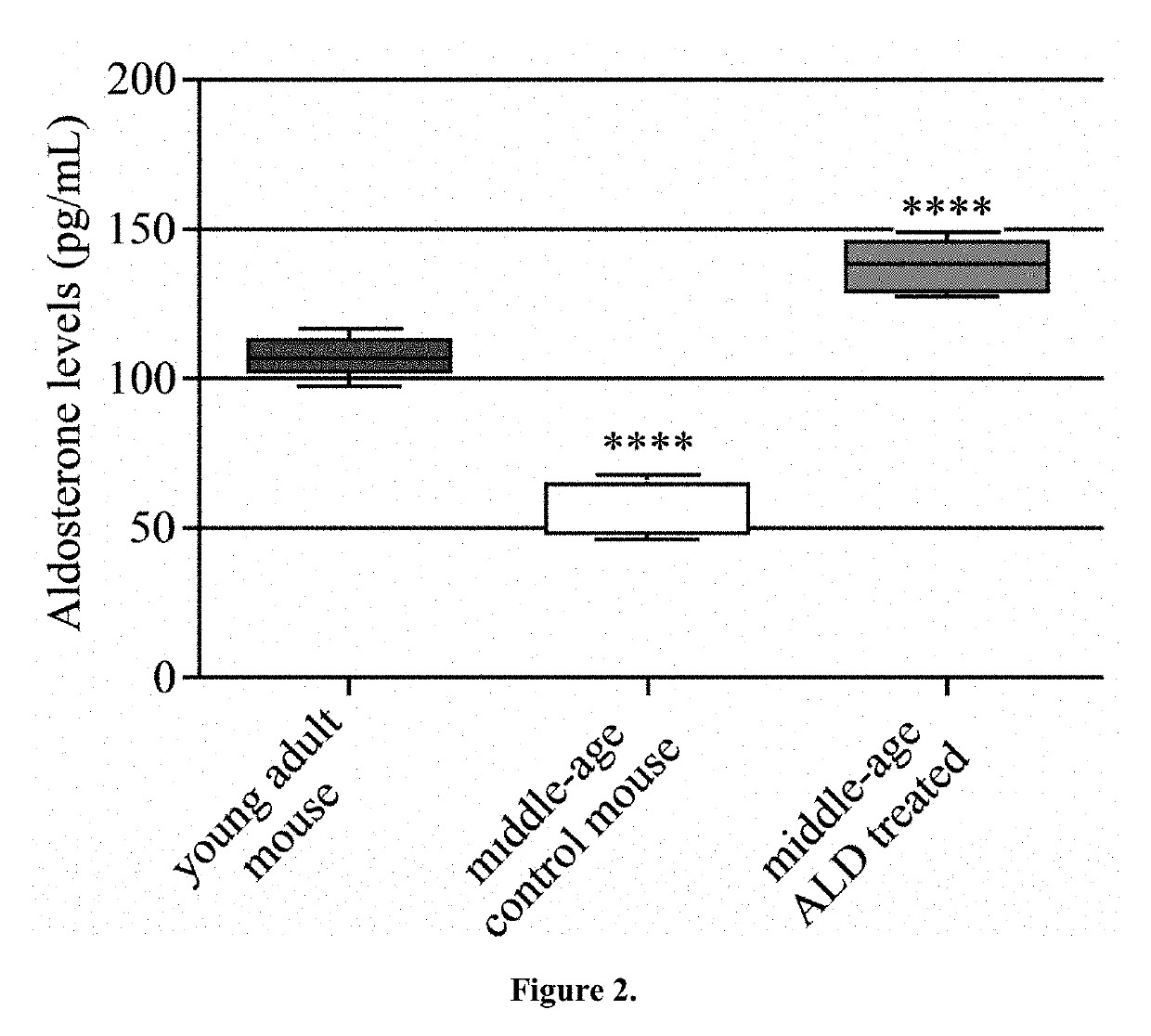Hormone treatment for age-related hearing loss-presbycusis
a hearing loss and hormone therapy technology, applied in the field of age-related hearing loss and disorders, can solve the problems of life-threatening, depression, anxiety, and the ability to communicate in family situations with spouses, siblings, and significant declines in workplace productivity, so as to reduce arhl, increase the effect of hormones, and reduce the dosing of hormones
- Summary
- Abstract
- Description
- Claims
- Application Information
AI Technical Summary
Benefits of technology
Problems solved by technology
Method used
Image
Examples
example 1
[0090]CBA / CaJ mice (The Jackson Laboratory, Bar Harbor, Me.) were treated with aldosterone doses 0.00048 mg / day to 0.00476 mg / day to determine the dose-response curve using slow-release, subcutaneous ALD pellets (Innovative Research of America-IRA, Sarasota, Fla.). After 60 (2 months) or 120 days (4 months) of ALD implantation, mice were anesthetized with a combination of ketamine and xylazine (100 μl i.p. of sterile saline containing 100 mg / ml ketamine and 80 mg / ml xylazine) for ABR measurements. A dose of 0.0016 mg / day was found to be optimal for ABR threshold improvements relative to age-matched control mice.
example 2
[0091]Serum ALD levels decrease with age in humans (Hegstad, et al., Aging and aldosterone. Am J Med. 1983 March; 74(3):442-8; Hallengren B., et al., 80-year-old men have elevated plasma concentrations of catecholamines but decreased plasma renin activity and aldosterone as compared to young men. Aging (Milano). 1992; 4(4):341-5; Bauer, Age-related changes in the renin-aldosterone system. Physiological effects and clinical implications. Drugs Aging. 1993; 3(3):238-45; Belmin, et al., Changes in the renin-angiotensin-aldosterone axis in later life. Drugs Aging. 1994; 5(5):391-400; Mulkerrin, et al., Aldosterone responses to hyperkalemia in healthy elderly humans J Am. Soc. Nephrol. 1995; 6(5):1459-62) and other mammals, including rodents (Brudieux, et al., Age-related decreases in plasma adrenocorticotropic hormone, corticosterone, and aldosterone responses to exogenous corticotropin-releasing hormone in the rat. Gerontol. 1995; 41(6):308-14; Magdich, Age and the effect of adrenocort...
example 3
[0097]Spiral ganglion neuron (SGN) degeneration with age is an important biomarker of presbycusis-age-related hearing loss (ARHL). ARHL represents the top communication deficit and neurodegenerative disorder in aged populations. A relationship between aldosterone (ALD) serum levels and the severity of ARHL in old human subjects suggests that ALD may be involved in the etiology of ARHL (Tadros, et al., High Serum Aldosterone Levels Correlate with Lower Hearing Thresholds in Aged Humans: A Possible Protective Hormone against Presbycusis. Hearing Research. 2005; 209:10-18). In addition, SGN density declines 30-60%, from apex to base in old CBA / CaJ mice compared to young adults (Tang, et al., Age-related hearing loss: GAB A, nicotinic acetylcholine and NMDA receptor expression changes in spiral ganglion neurons of the mouse. Neuroscience.2014; 259:184-93).
[0098]It has been shown that higher serum aldosterone (ALD) levels correlate with lower hearing thresholds in older human subjects (T...
PUM
| Property | Measurement | Unit |
|---|---|---|
| section-thickness | aaaaa | aaaaa |
| time | aaaaa | aaaaa |
| physiological place-frequency | aaaaa | aaaaa |
Abstract
Description
Claims
Application Information
 Login to View More
Login to View More - R&D
- Intellectual Property
- Life Sciences
- Materials
- Tech Scout
- Unparalleled Data Quality
- Higher Quality Content
- 60% Fewer Hallucinations
Browse by: Latest US Patents, China's latest patents, Technical Efficacy Thesaurus, Application Domain, Technology Topic, Popular Technical Reports.
© 2025 PatSnap. All rights reserved.Legal|Privacy policy|Modern Slavery Act Transparency Statement|Sitemap|About US| Contact US: help@patsnap.com



